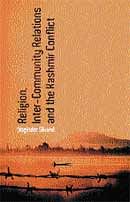
Religion, inter-community relations and the Kashmir Conflict
Yoginder Sikand
Rupa
2011, pp 224
595
Religion, Inter-Community Relations and the Kashmir Conflict in many ways seems to be known information repackaged in a new publication. Yoginder Sikand, an expert on Indian Islam, has now compiled a collection of his thoughts and reflections, penned down during his various visits to Jammu and Kashmir over the last couple of years.
What distinguishes this book from the numerous on the state/region is that here Sikand very unambiguously states what many writers, journalists and activists have struggled to articulate in politically correct ways: that at the heart of the Kashmir issue lies religion.
While the political angle of the Kashmir issue is not to be dispensed off with, inhabitants of the state know that religion is the crux, and Sikand has dared to acknowledge in this book: that “…the roots of the seemingly intractable Kashmir imbroglio lay less in the economic or political sphere and more in the religio-cultural realm, specifically in imagining Hindu and Muslim religious and community identities as being promised on unrelenting hostility towards each other.” “…at the very root of the conflict was the dominant perception — among both Hindus and Muslims — of each other as historical adversaries, and of their religions as mutually opposed to each other.’
The title is somewhat misleading though — except for one chapter, all the others are about regions in Jammu. Thus, the book should actually have been titled ‘Religion, Inter-community Relations and the Kashmir Conflict in Jammu’.
This in no way diminishes its significance. Too often the region of Jammu in the troubled state is simplistically referred to as ‘Hindu-majority Jammu’. Yet, that is only a slight majority; three major divisions of Jammu — Doda, Poonch and Rajouri — are Muslim-majority areas and the community is growing.
Jammu is far more ethnically diverse than the Kashmir Valley and also saw great bloodshed during the 1947 partition. Many of the jihadi leaders in Pakistan today, such as Hafeez Saeed, are from Jammu and it is but perhaps inevitable that attitudes among both Hindus and Muslims are hardened.
If the RSS has strong roots among the Hindus of Jammu, then so do hardline Muslim organisations like Tablighi Jamat and the Ahl-i-Hadees, which have strong roots among the Muslims of Jammu. Infiltration of militants from Pakistan across the line of control is also considerably higher in the Jammu region than in the Kashmir Valley. Yet we rarely hear of how the Kashmir conflict plays out in this region and about inter-community relations here.
This is where Sikand’s work plugs a gap. Yet, it is not without its shortcomings. Chapters have no dates and this makes it difficult for the reader to relate to events and timelines. Neither are the two communities given an even-handed treatment. Greater space is devoted to presenting a more peaceful and inclusive face of Islam, which may have something to do with Sikand’s personal inclination.
‘Oppression of Muslims in India’ too surfaces throughout the book with predictable regularity, and is used to explain anti-Indian sentiments amongst the Muslims of Jammu and Kashmir. However, there is no mention of ‘oppression of Hindus in Pakistan’, and no reflection on how this might play out on Hindus in India.
This ‘oppression of Muslims in India’ is also at odds with what many of Sikand’s interviewees are at pain to explain: that the concept of jihad cannot be applied by Muslims to India since the community has the full freedom of religion, worship and propagation of Islam in India. And finally, there is the odd reasoning that finds a constant symmetry between the Indian armed forces and the jihadi insurgents in Jammu and Kashmir.
These shortcomings notwithstanding, the book provides the reader with interesting and useful information, and an overview of inter-communal relations in Jammu (and not in Kashmir).
Deccan Herald is on WhatsApp Channels| Join now for Breaking News & Editor's Picks